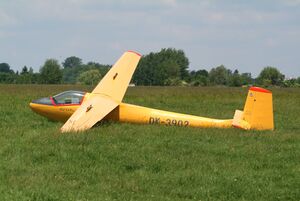Orlican VT-16 Orlik
Topic: Engineering
 From HandWiki - Reading time: 3 min
From HandWiki - Reading time: 3 min
| VT-16 Orlik | |
|---|---|

| |
| Role | Club and competition single-seat glider |
| National origin | Czechoslovakia |
| Manufacturer | Orlican |
| Designer | Jiri Matejček |
| First flight | August 1959 |
| Number built | c.85 |
The Orlican VT-16 Orlik is a single-seat club glider, serving Czech gliding clubs and setting several national records in the early 1960s.
Design and development
The VT-16 Orlik was designed by Jiri Matejček and is a high-wing monoplane of all-wood construction, except that the skin is stabilized with polystyrene foam. Its wing has a single spar structure with a forward torsion box; the whole wing is plywood skinned and foam filled, allowing the ribs to be comparatively widely spaced. In plan it is straight-tapered with blunt tips; there are 3° of dihedral. It has conventional plain ailerons and spoilers at mid-chord, which extend both above and below the wing. At the time of its first flight in August 1959 it was a Standard Class glider with a 15 m (49 ft 3 in) span. Later aircraft had 16 m (52 ft 6 in) and 18 m (59 ft 1 in) spans but it was the 16 m version that went into series production.[1][2]
The fuselage of the Orlik is a semi-monocoque of deep oval cross-section, tapering to the tail. The single-seat cockpit, placed just ahead of the wing, is covered by a side-hinged blown canopy. Its tail is conventional with a straight-edged, ply-covered and foam-filled all-moving tailplane, fitted with an anti-balance tab, mounted on top of the fuselage and ahead of the small fin which is constructed in the same way. The fabric-covered, balanced rudder is broad and taller than the fin, reaching down to the keel. Overall, the vertical tail has almost upright straight edges and a blunt tip. The Orlik has a fixed, semi-recessed monowheel ahead of the wing leading edge, assisted by a small tail bumper.[1][2]
Operational history
25 VT-16 Orliks were produced[2] in the first series production run, going to Czech gliding clubs.[1] The Orlik also set several new Czech national gliding records during 1962.[1] 15 VT-16s and 48 VT-116s remain on the Czech civil aircraft register in 2010, though some are disassembled.[3]
Variants
- VT-16 Orlik
- about 25 built.
- VT-116 Orlik II
- more than 50 built.
Aircraft on display
- Prague Aviation Museum, Kbely: Orlik I OE-2408[4]
Specifications (VT-16)
Data from The World's Sailplanes II, p.62-3[2]
General characteristics
- Crew: one
- Length: 7.40 m (24 ft 3 in)
- Wingspan: 16.0 m (52 ft 6 in)
- Wing area: 12.80 m2 (137.8 sq ft)
- Aspect ratio: 20.0
- Airfoil: NACA 64-818
- Empty weight: 215 kg (474 lb)
- Gross weight: 320 kg (705 lb)
Performance
- Maximum speed: 220 km/h (140 mph, 120 kn) placard, smooth air
- Stall speed: 61 km/h (38 mph, 33 kn)
- Maximum glide ratio: 32.5 at 71 km/h (44 mph; 38 kn)
- Rate of sink: 0.56 m/s (110 ft/min) at 63 km/h (39 mph; 34 kn)
- Wing loading: 25.0 kg/m2 (5.1 lb/sq ft)
See also
Related development
- Orlican VSO 10 Single-seat glider built in glass-fibre plus aluminium, steel and wood.
References
- ↑ 1.0 1.1 1.2 1.3 Hardy, Michael (1982). Gliders & Sailplanes of the World. London: Ian Allan Ltd. p. 140. ISBN 0-7110-1152-4.
- ↑ 2.0 2.1 2.2 2.3 Shenstone, B.S.; Wilkinson, K.G. (1963). The World's Sailplanes. II. Organisation Scientifique et Technique Internationale du Vol à Voile (OSTIV) and Schweizer Aero-Revue. pp. 62–3.
- ↑ Partington, Dave (2010). European registers handbook 2010. Air Britain (Historians) Ltd. ISBN 978-0-85130-425-0.
- ↑ Ogden, Bob (2009). Aviation Museums and Collections of Mainland Europe. Air Britain (Historians) Ltd. p. 63. ISBN 978-0-85130-418-2.
 |
 KSF
KSF
